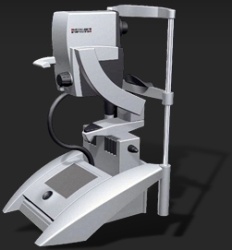Apr 12 2010
Heidelberg Engineering is introducing SPECTRALIS®, an office-based imaging device for tracking and measuring axonal change, at the 2010 meeting of the American Academy of Neurology in Toronto.
 SPECTRALIS Tracking Laser Tomographer
SPECTRALIS Tracking Laser Tomographer
The SPECTRALIS Tracking Laser Tomographer uses its on-board Nsite Axonal Analytics™ to track and measure axonal changes within the retinal nerve fiber layer (RNFL) by capturing high resolution cross-sectional images of the eye.
Numerous peer-reviewed clinical studies have been published in the last several years investigating the relationship between RNFL and neurodegenerative diseases, especially multiple sclerosis. Patients with multiple sclerosis have been shown to have a thinner RNFL than healthy patients, and this is true for patients with and without prior episodes of optic neuritis.1 In addition, RNFL thickness has been shown to correlate with symptoms measured in physical disability scores such as the Expanded Disability Status Scale (EDSS).1
“Even though SPECTRALIS offers 100 times higher resolution than an MRI, we don't expect our instrument to replace the role of MRI neurologists,” noted Dr. Kester Nahen, vice president of global marketing and business development at Heidelberg Engineering, “but we do believe that having an office-based instrument which can measure unmyelinated nerve loss in a fast and easy way will be a valuable asset for helping to evaluate patients with neurodegenerative conditions.”
The SPECTRALIS Tracking Laser Tomographer is a non-invasive instrument which uses light to create 2D and 3D images of the back of the eye. This technology has one hundred times the resolution of MRI and utilizes a unique combination of two imaging methods: optical coherence tomography (OCT) and confocal scanning laser ophthalmoscopy (cSLO). This combination drives the company’s proprietary TruTrack™ active eye tracking technology which not only provides high-resolution, detailed images of the layers of the eye, but enables precise measurements for tracking subtle change over time using the AutoRescan™ feature.
The technology is already in use at many leading multiple sclerosis centers around the world. SPECTRALIS will be demonstrated at booth #1544 at this year’s annual meeting of the American Academy of Neurology from April 10-17 in Toronto.